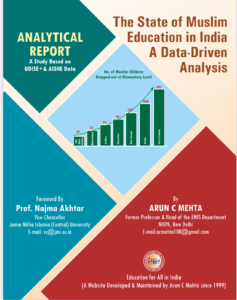Will Lower Eligibility for Assistant Professor Lead to a Decline in the Quality of Teaching? (2023)
Top US Institutions for Remote Learning: A Guide to Digital Education (2023)
Successful Study Habits for College Students (2023)
Current State of Education: College Pressures (2023)
Education in India: College Teachers and College Problems (2023)
The Crisis of Quality in Higher Education in India (2023)
Higher Education in India: Current Status, Chellanges, Programmes & Policies
Status
Higher Education in India is a diverse and complex system consisting of universities, colleges, and research institutions that offer various academic programs across various disciplines. India’s higher education system is the third-largest in the World in enrollment, with over 36 million students enrolled in higher education institutions. There are more than 900 universities and over 40,000 colleges in the Country.
The State of Muslim Education in India: A Data-Driven Analysis by Arun C Mehta (2023)
Higher Education in India: Overcoming Challenges & Embracing Opportunities 2023
The Rising Challenge of Increasing Education Costs for Families in India (2023)
Muslims Gross Enrolment Ratio at Higher Education Level (2020-21)
Contemporary Challenges in Indian Higher Education: A Concise Appraisal based on AISHE 2020-21 Data
The Impact of Globalization on the Quality of Indian Higher Education
The Challenges of Globalization for Indian Higher Education (2023)
Role of Government in the Globalization of Indian Higher Education (2023)
Opportunities of Globalization for Indian Higher Education (2023)
The Globalization of Indian Higher Education: Trends and Implications
Challenges and Opportunities of Foreign Faculty Recruitment in Indian Universities
Global Rankings & Indian Higher Education: Analyzing the Influence of Globalization
Indian Students Abroad: Exploring the Brain Drain Phenomenon
Economic Influence of International Students on India’s Higher Education System
The Future of Internationalization: Post-Pandemic Prospects for Indian Higher Education
Analysis of Muslim Enrollment at Higher Education Level in India: AISHE 2020-21 (2023)
Embracing Diversity: The Promise of Cultural Pluralism in Indian Universities (2023)
Cultural Diversity in Indian Higher Education: Its Pros and Cons (2023)
Building Global Appeal: Opportunities for Indian Higher Education (2023)
Analyzing Scheduled Castes Higher Education Enrolment in India based on AISHE 2020-21 Data
Despite significant achievements, India’s higher education system is plagued by a number of challenges, including inadequate infrastructure and resources, uneven quality of education, outdated curricula, a shortage of faculty, and a lack of funding. Despite these challenges, India has made significant progress in recent years in expanding access to higher education, increasing enrollment rates, and improving the quality of education. The Gross Enrollment Ratio in higher Education in India has recently improved, and it is around 27 percent, but it still is lower than many other developing countries.
Competitive Examinations in India for Higher Education: Technical, Medical, and Others
Meeting the Challenges of Indian Higher Education: A Comprehensive Perspective (2023)
Unlocking the (Challenges) Secrets of India’s Higher Education Quandary
Challenges
One of the major challenges in higher education is the lack of adequate infrastructure and resources. Many institutions suffer from a shortage of qualified faculty (mostly state-run institutions), outdated curriculum, and insufficient funding. There is also a significant rural-urban divide, with most high-quality institutions concentrated in urban areas. Another challenge is the low employability of graduates, which may be because of the mismatch between the skills they acquire in college and the job market’s needs.
University Research: Its Importance and Implications
Programs
India’s higher education system offers a wide range of programs, including undergraduate, postgraduate, and doctoral degrees, as well as diploma and certificate courses. These include the establishment of new universities and colleges, the expansion of existing institutions, and the introduction of reforms aimed at improving the quality of education and increasing access to higher education for marginalized communities.
The Impact of Globalization on Education in India 2023
Education & Employment in India: Navigating Challenges & Unlocking Opportunities 2023
In addition, the government initiated several programs to improve the quality & accessibility of higher education. One of the most effective programs is the Rashtriya Uchchatar Shiksha Abhiyan, which aims to provide funding for the development of new institutions & the improvement of existing ones. Other programs include the Global Initiative of Academic Networks (GIAN), which aims to attract foreign faculty to Indian institutions, and the National Institutional Ranking Framework (NIRF), which ranks institutions based on various parameters such as teaching, research, and outreach.
Power of Education, Unlocking India’s Potential 2023
Policies
The government has also implemented several policies to address the challenges faced by higher Education in India. One of the key policies is the National Education Policy (NEP) 2020, which aims to transform the education system by promoting interdisciplinary learning, increasing funding, and encouraging internationalization. In addition, the government has also launched several initiatives to promote online learning, such as the SWAYAM platform, which offers free online courses from top institutions.
GER at Higher Education Level in India: Brief Analysis, 2023
Understanding the Role of Gender Parity Index in Higher Education in India, 2023
Unlocking Solutions to Examination Stress: A Deep Dive into India’s Kota Coaching Hub (2023)
The National Education Policy 2020 also aims to transform the higher education system by promoting interdisciplinary education, expanding access to online and distance learning, and encouraging the development of research and innovation. The policy also emphasizes the importance of improving the quality of teaching and learning, promoting equity and inclusion, and ensuring that higher education institutions are financially sustainable.
Finding Your Voice: Developing a Unique Style in Freelance Writing
In conclusion, while India’s higher education system faces significant challenges, the government’s commitment to expanding access and improving the quality of education is a positive sign for the future. With continued investment in infrastructure, faculty development, and innovative teaching and learning methods, India’s higher education system has the potential to become a global leader in higher education.
Gender Parity Index Higher Education in India (AISHE 2021-22) [PDF]
Higher Education Statistics at a glance: 2011-12 To 2015-16
Internationalization & Globalization on Higher Education 2023
Is Technology Important for Higher Education in India?
50% Ger At Higher Education Level In India 2035 Achievable?
AIHES & Status of Higher Education in India (2023)
Publications of Prof. Mona Khare on Higher Education In India
National Institutional Ranking Framework (NIRF) & World University Ranking (WUR) 2022
Fifty Percent Increase In Higher Education Enrolment By 2035 Possible
Status of The State Open Universities in India, A Report by Cemca, New Delhi
Data on Higher Education In India
A Note on Higher Education In India (HE-MIS), Arun C Mehta
Other Posts/Publications
Education in Economic Survey 2022-23 (Es 2022-23)
Education Planning for Sustainable Development
Issues & Challenges Indian Education System is Facing
Private Vs. Public Education & Impact on Student Outcomes
Role of Private Institutions in Indian Education
Sustainable Development Goal 4: Quality Education, 2020-21 (India)
8 Pros and Cons of Delegating Your Writing Assignments to Experts
Most Recent Publications/Posts: Education for All In India, 2023




